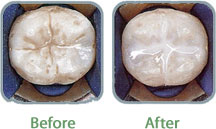(206) 498-2212
(206) 498-2212

Dental sealants are thin plastic coatings that are applied to the grooves on the chewing surfaces of the back teeth to protect them from tooth decay. Most tooth decay occurs on these surfaces. Sealants protect the chewing surfaces from tooth decay by keeping germs and food particles out of these grooves.
Permanent molars are the most likely to benefit from sealants. The first molars usually come into the mouth when a child is about 6 years old. Second molars appear at about age 12. It is best if the sealant is applied soon after the teeth have erupted, before they have a chance to decay.
Applying sealants does not require drilling or removing tooth structure. The process is short and easy. After the tooth is cleaned, a special gel is placed on the chewing surface for a few seconds. The tooth is then washed off and dried. Then, the sealant is painted on the tooth. The dentist or dental hygienist also may shine a light on the tooth to help harden the sealant. It takes about a minute for the sealant to form a protective shield.
If you wonder a sealant might be an effective solution for your dental issues, please call us today to schedule a free consultation. We will be able to provide you with more detailed information about the sealant process and are more than happy to answer any questions that you might have about preventative dental care.
No, getting a sealant is painless. No drilling or shots are necessary. Normal daily routines and meals can resume immediately after sealants are applied.
Sealants can only be seen up close. Sealants can be clear, white, or slightly tinted.
As with anything new that is placed in the mouth, you may feel the sealant with the tongue. Sealants, however, are very thin and only fill the pits and grooves of molar teeth.
A sealant can last for as long as 5 to 10 years. Sealants should be checked at your regular dental appointment and can be reapplied if they are no longer in place.